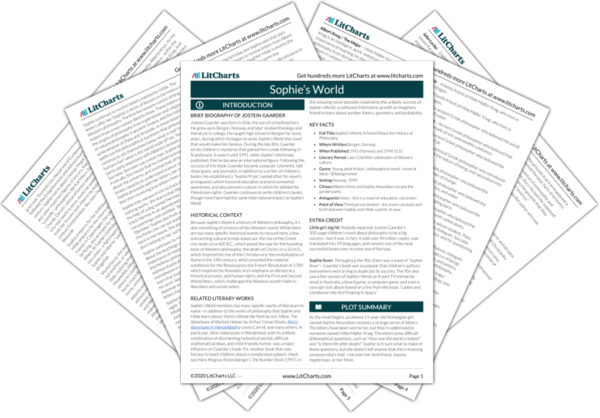Summary
Analysis
Sophie walks down the path away from her home. She notices a small lake that she’s never seen before. As if in a trance, she walks to the lake, where she finds a small boat. She paddles across the water, sitting in the boat, and arrives at a cabin. Boldly, she enters the cabin, where she finds a table, a typewriters, and a painting of a man, titled, “Berkeley.” There’s also another painting of a white house, captioned, “Bjerkely.” Sophie notices a large brass mirror hanging on the wall. When Sophie stares into the mirror and winks with one eye, her reflection winks at her with both eyes, much to her surprise.
The book’s fantastical and meta-fictional plot starts to become more central in this chapter, as Sophie actually does more things besides study philosophy. Berkeley, as we’ll learn, is a philosopher whose ideas have particular relevance to this novel. These paintings and the brass mirror will also be important symbols.The mirror acts as a traditional symbol of introspection and self-study, but here it also seems to have something fantastical about it, as Sophie’s reflection winks at her.
Themes
Sophie explores the cabin. She finds hair on the floor that matches the color of Hermes’ fur. She realizes that Hermes and Alberto live in the cabin. Sophie notices a wallet lying on a table. It contains a school ID for a girl named Hilde Møller Knag. She also notices an envelope, addressed to her. Suddenly, Sophie hears Hermes barking—quickly, she grabs the envelope and rushes out of the cabin’s back door.
The strange coincidences keep adding up. Sophie also continues to find pieces of evidence linking her to Hilde Møller Knag—a girl we still know nothing about.
Themes
Rushing away from the cabin, Sophie opens the envelope, and finds a set of questions, including, “What came first, the chicken or the “idea” chicken?”; “Are we born with innate ideas?”; “What is the difference between a plant, an animal, and a human?”; “What does it take to lead a good life?”
The questions Sophie receives in the mail are becoming more diverse and complicated, reflecting the progress Sophie’s been making in her philosophical education.
Themes
Sophie returns to her house, where she’s surprised to find Mom standing outside. Mom has been frantic—she was going to call Joanna to find Sophie. Sophie says she’s been walking in the woods. Mom nods, and asks if she was with her crush. Sophie begins to cry—she doesn’t like to see her mother like this. She tells her mother about the boat and the cabin, but not the envelopes. She also admits she has no boyfriend. She starts to tell her mother that a philosopher lives in the cabin, but Mom cuts her off. Mom explains that the cabin Sophie visited is called the Major’s Cabin—a crazy old military man used to live there, years ago.
In this section, we see Sophie’s Mom at her best and worst. It’s admirable that she cares so much about Sophie’s safety, but there’s also something oddly pathetic about her inability to let Sophie off on her own for even a few hours. Tellingly, Sophie’s mother refuses to even listen when Sophie begins to tell her about her philosopher friend. This is the first the “the Major” is mentioned—but he will be become a crucial figure soon.
Themes
Get the entire Sophie’s World LitChart as a printable PDF.

Sophie writes Alberto a letter in which she admits that it was she who visited the cabin. She admits that she’s unsure if she likes Plato, and doesn’t know if he was right to believe in an immortal soul. She likes this idea, however, because it makes her feel better about her dead Granny. Finally, Sophie apologizes for rowing Alberto’s boat without pushing it back to the other side of the lake.
Whether or not Sophie literally believes in the Platonic ideal of the soul, she finds comfort and beauty in the ideal. At the same time that she flirts with Plato’s philosophy, she sends playful messages to Alberto, suggesting a fundamental link between the content of Sophie’s lessons and the unorthodox means by which she’s learning these lessons.
Themes
Having finished her letter, Sophie begins thinking about the questions in the last letter she received. She’s unsure how to answer any of them, though she suspects that the difference between a human and an animal is that a human can think about philosophical matters. She sends her own letter by placing it near herden with a lump of sugar on top.
Sophie is a good philosophy student who already recognizes the importance of rationalism and deep thought.
Themes












